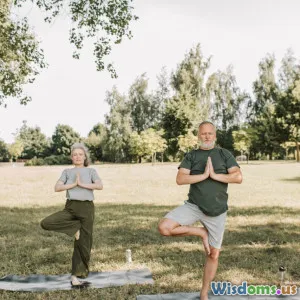
Can Yoga Postures Alone Lead to Lasting Spiritual Fulfillment
7 min read Explore whether yoga postures alone can bring lasting spiritual fulfillment or if deeper practices are essential. (0 Reviews)
Can Yoga Postures Alone Lead to Lasting Spiritual Fulfillment?
Yoga has become a global phenomenon, predominantly celebrated for its physical benefits and calming effects. Millions turn to asanas—the postural aspect of yoga—to improve flexibility, strength, and overall well-being. However, a compelling question persists: Can yoga postures alone lead to lasting spiritual fulfillment?
This article dives deep into the essence of yoga, separating the physical from the spiritual, and uncovers how wellbeing interlaces with inner growth. By examining scriptural insights, scientific observations, and real-world experiences, we'll assess whether asanas alone are enough to achieve spiritual enlightenment or if more profound practices are required.
Understanding Yoga Beyond Postures
Yoga originates from ancient Indian philosophy, wherein the word “yoga” means “union” — the union of the individual self with universal consciousness. Traditionally, yoga encompasses eight limbs (Ashtanga Yoga), including ethical disciplines (Yama, Niyama), physical postures (Asanas), breath control (Pranayama), sense withdrawal (Pratyahara), concentration (Dharana), meditation (Dhyana), and ultimately Samadhi (spiritual absorption).
The Role of Asanas in Yoga
Asanas are merely one limb of this extensive practice. They serve as the preparatory stage for deeper yogic endeavors by building physical stamina and comfort for prolonged meditation and focus. Bhagavad Gita 6.11 says:
“To be steadfast in yoga, one must make the body firm and flexible.”
Hence, postures are foundational but not the ultimate goal.
Physical Benefits of Yoga Postures
Engaging regularly in asanas can:
- Increase muscle strength and balance. A 2015 Harvard study showed consistent yoga practitioners had improved muscle tone and joint health.
- Reduce stress via lowered cortisol levels, promoting relaxation.
- Enhance mindfulness by cultivating present-moment awareness.
These benefits contribute to an improved quality of life, but can they elevate the spirit deeply and permanently?
Spiritual Fulfillment: What Does it Mean?
Spiritual fulfillment transcends transient happiness; it represents a profound sense of unity, purpose, and inner peace. It is often described as lasting freedom from suffering and illusion.
Philosopher Aldous Huxley defined spiritual fulfillment as:
“The experience of being connected to something greater than oneself, leading to enduring peace.”
In yogic wisdom, this corresponds to realizing the Atman (self) and its unity with Brahman (universal consciousness).
Are Postures Enough for Lasting Fulfillment?
The Limitations of Physical Yoga Alone
Despite their many benefits, postures primarily address the body and, secondarily, the mind. They create optimal conditions for subsequent spiritual work but do not directly engage with inner cognitive, emotional, or ethical transformations.
Dr. Sat Bir Singh Khalsa, a leading yoga researcher, highlights:
“Physical practice alone may improve wellbeing but often lacks the depth necessary for spiritual transformation.”
For instance, Yoga Journal surveys suggest many practitioners cite relaxation and fitness as primary outcomes, with fewer experiencing deep spiritual connection solely through physical practice.
The Need for Meditation and Ethical Practice
Meditation cultivates concentration and introspection, providing direct tools for transcending ego and illusion. Ethical disciplines guide behavior toward harmony with self and others, essential for profound peace.
In contrast to asanas, these practices foster "inner contentment and liberation," key to lasting spiritual fulfillment.
—
Other Supporting Practices in Yoga for Spiritual Growth
- Pranayama (Breath Control): Managing the breath regulates energy flow and calms the nervous system, creating conditions conducive to spiritual realization.
- Dhyana (Meditation): Observing thoughts without attachment leads to freeing the mind from distraction and identifying with the eternal self.
- Self-Inquiry and Detachment: Questioning the nature of self and relinquishing cravings and attachments dissolve suffering at its root.
—
Real-World Insights and Examples
Case Study: Himalayan Yogis
Many Himalayan ascetics devote years to intense meditation beyond physical postures, achieving states of self-realization reported in ancient and modern accounts.
Modern Teachers’ Perspective
B.K.S. Iyengar, authority on asana practice, emphasized that "postures are the threshold, not the destination". Similarly, Swami Satchidananda pointed to meditation as the core path.
—
Conclusion: Integration Is Key
Yoga postures alone deliver valuable physical and mental health benefits but rarely suffice for permanent spiritual fulfillment. True yoga, in the deepest sense, requires integrating asanas with breath work, meditation, ethical living, and self-inquiry.
Wellness at the body level is important as a foundation, yet lasting spiritual fulfillment rests on profound inner transformation cultivated by the entire yogic path. For sincere seekers, combining physical discipline with mindfulness and moral principles opens the doorway to enduring peace and spiritual awakening.
In pursuing yoga, recognize asanas as a vital beginning—a key that unlocks but does not finish the journey toward union and enlightenment.
Ready to deepen your practice? Consider exploring meditation techniques or ethical precepts from traditional yoga texts to complement your asana routine and cultivate lasting spiritual growth.
References
- Feuerstein, Georg. The Yoga Tradition: Its History, Literature, Philosophy and Practice., 2001.
- Khalsa, Sat Bir Singh, et al. "A Comprehensive Review of the Effects of Yoga on Physiological and Psychological Parameters." Evidence-Based Complementary and Alternative Medicine, 2013.
- Iyengar, B.K.S. Light on Yoga, 1966.
- Harvard Health Publishing. "Yoga for Better Health," 2015.
- Yoga Journal. 2020 Yoga Practice Survey.
Rate the Post
User Reviews
Popular Posts





















